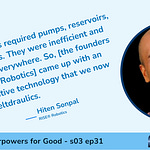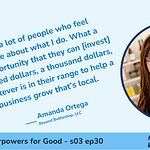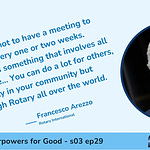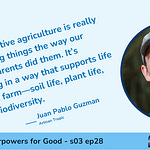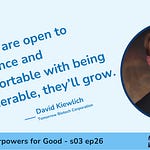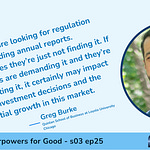Why We Keep Showing Up Together
Every month, Jen and I hop on a call to trade notes, swap links, and compare what’s resonating. It’s become a favorite ritual because it lets us zoom out and make sense of a very fast month—what we published, what we learned, and where our communities are headed next. We’re aligned on mission and complementary in approach: we both want to help people use money for good—while being as rigorous about real-world impact as we are about financials. That’s why we keep encouraging readers to subscribe to both publications; you see more of the picture that way.
This month, our conversation kept circling around a handful of pieces that sparked big reactions across our communities:
Superpowers for Good: SuperCrowd25: A Movement on the Rise
Superpowers for Good: Power Up October
Main Street Journal: Scamming Social Change
Main Street Journal: Plant DePIN Stations for Fun and Profit
Main Street Journal: Housing Cooperatives & the Better Abundance
We also name-checked two thinkers whose work regularly sharpens the discussion: Michael Shuman and Paul Spinrad.
Authenticity, Impact, and What Changes When You Meet the Founder
A thread we returned to repeatedly is the gap between pitch-deck promises and the reality you can feel when you look a founder in the eye—even if it’s through a webcam. Jen pointed to how hearing a human, unscripted explanation can dispel both confusion and “impact-washing” skepticism. I see that dynamic every quarter in our Live Pitch sessions: judges arrive with carefully formed opinions and then, after Q&A with founders, their scores often shift—sometimes dramatically. That post-conversation “re-rating” speaks to the power of authentic engagement for investors and founders alike.
Michael Shuman’s “Scamming Social Change” gave us a crisp lens for that authenticity test. His basic argument: be wary of grand claims about fixing systemic problems with thin mechanisms. He challenged the marketing logic of some “impact” narratives that simply don’t add up when you trace how the benefits would actually reach people. For impact investors, the takeaway is simple: scrutinize the causal chain, not just the press release.
Three Housing Ideas Worth Stealing (and Scaling)
Housing kept bubbling up as a cross-community priority—because you can’t talk about poverty, health, or mobility without talking about where people live.
Small, Local, Many
Michael’s “Better Abundance” essay argues that big problems don’t always demand singular, big solutions; sometimes “many small things in many places” perform better, especially when they’re rooted in community context. Jen loved that framing—and it tracks with what we see across Main Street finance and impact crowdfunding: local teams solving local problems, with models that travel.Co-ops Change the Market, Not Just the Tenant’s Rent
Jen highlighted Burlington’s Champlain Housing Trust—managing roughly 3,000 affordable homes—as an example of how cooperative models can reset price expectations across a region by forcing the broader market to compete with a fairer baseline. She also flagged a Swiss city where a notable share of residents lives in nonprofit housing—and pointed to eye-poppingly low homelessness figures. The point isn’t that co-ops alone “solve” homelessness; it’s that a portfolio of modest, durable interventions can shift the whole system.ADUs as a Practical On-Ramp
Closer to home, Jen’s local planning commission in Keene ran an ADU Challenge: homeowners volunteered real sites and constraints; architects and students designed tailored, buildable options; and a $5,000 prize helped surface practical patterns. Policy may permit ADUs on paper, but many would-be “home creators” still need a nudge through the how-to. That kind of lightweight, civic R&D is a smart way to turn latent permission into actual housing.
We also touched on work from SuperCrowd25 showcasing rehab-first approaches and manufactured housing as naturally occurring affordable housing (NOAH)—permanent, dignified units that are too often conflated with RVs. In markets where down payments are out of reach, adding safe, lower-cost rentals is an immediate win—and investors can help expand that supply now, not “someday.”
A Curious Frontier: Plant DePIN
On the more experimental end, Paul Spinrad’s “Plant DePIN Stations for Fun and Profit” lit up our curiosity. I’m intrigued by the blend of community incentive design, real-world infrastructure, and open participation. We didn’t try to answer every technical or tokenomic question in our chat; we simply acknowledged an emerging space where Main Street builders might find new tools—if (and only if) the impact logic pencils out. As always: first prove the benefit, then scale the mechanism.
Movement Notes: SuperCrowd25 & Building the On-Ramps
If you missed it, SuperCrowd25 felt like a turning point—less a one-off event and more a widening lane for founders and investors who want returns and results. Our “Movement on the Rise” piece captured why: the people doing the work are getting better at telling the story, and the people funding the work are getting better at asking the right questions. When those two curves meet—clearer storytelling and sharper diligence—capital flows to what actually helps. That’s the movement.
And because better on-ramps matter, we’ll keep making space where founders can show up as themselves and investors can interrogate the “how,” not just the “what.” The more we normalize that practice—the short, human conversation where a founder’s logic is audible—the fewer “scamming social change” narratives will slip through undetected.
A Candid Ask: Power Up October
I also shared something personal with Jen: after 13 years of building this community—rebranding as Superpowers for Good four years ago and launching SuperCrowd two years back—we’re close to covering our costs, but not quite there. That’s the reason behind our Power Up October campaign. Much of our work remains free by design; paying members make that possible and receive meaningful perks in return (with even more for Max-Impact members). If you’ve found value in the shows, posts, or pitch sessions, this month is a great time to upgrade or sponsor.
Jen shared how the Main Street Journal sustains itself—often through NC3 partnerships and tax-deductible support—and she pledged to help amplify our effort. That kind of mutual aid between aligned media shops is how indie ecosystems survive.
Two Subscriptions, One Mission
If you read one of us, you’ll get good work. If you read both, you’ll get a fuller map—and, frankly, it’s still an affordable bundle for a year of actionable ideas. However you support us—subscribe, upgrade, sponsor, or simply share a favorite piece—thank you. We’ll keep earning it by elevating founders who solve real problems and by asking the impact questions that make everyone better.
—Devin
P.S. If you’re discovering this via the Main Street Journal, welcome!






